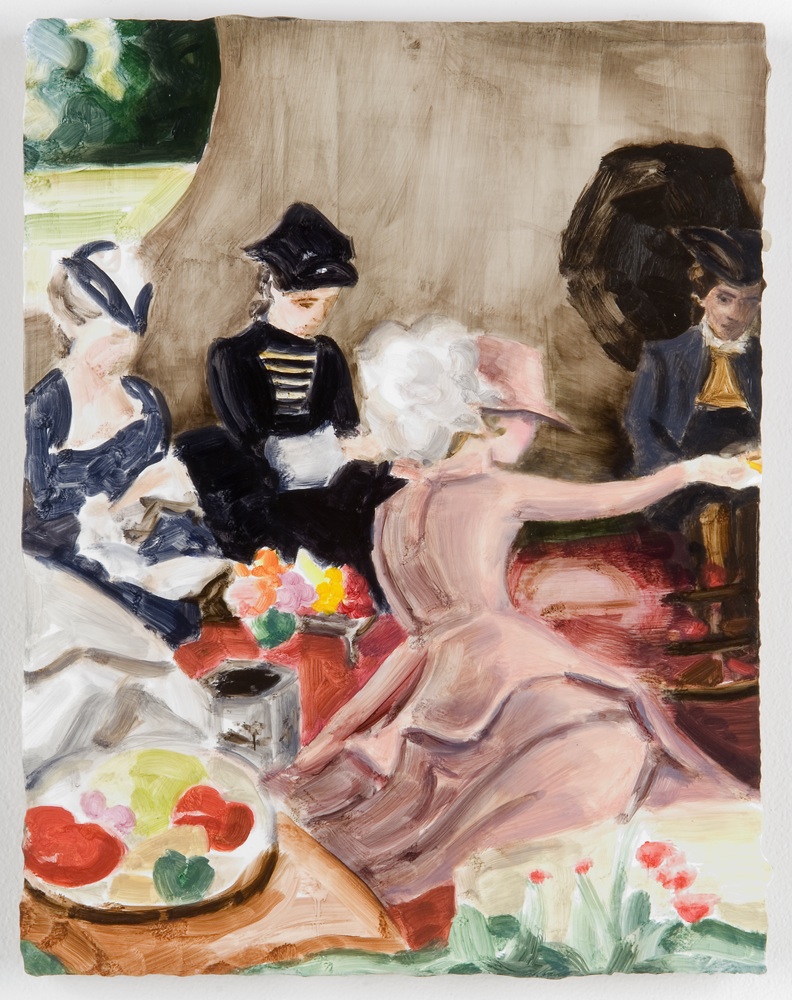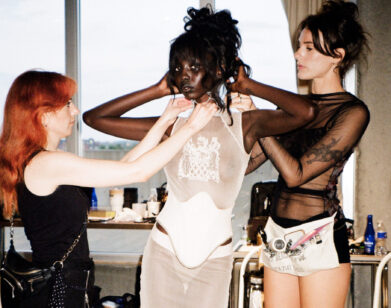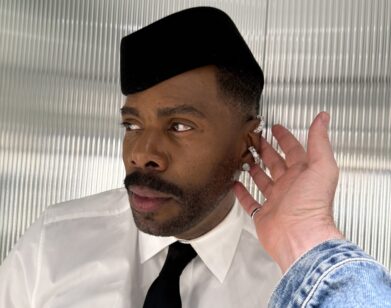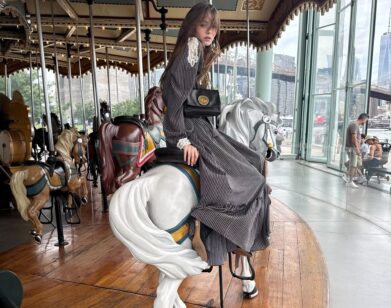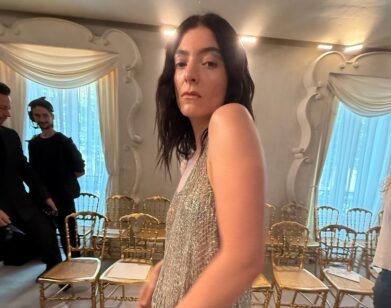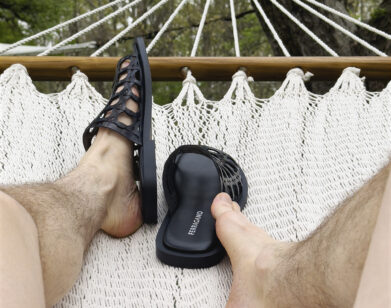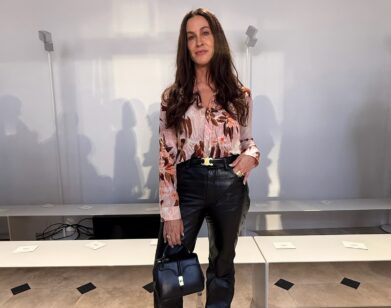The Look
The court of Versailles under the reign of Louis XVI and his queen Marie Antoinette celebrated creativity, individuality, and above all else, style. Naturally, this applied to their beauty regimens and practices. John Galliano’s Fall 2000 Dior couture collection depicted the splendor of Marie Antoinette’s 18th-century beauty, highlighting the pale skin, rosy cheeks, and colossal hair, but the over-the-top fantasy and glamour of it, translated through the lens of modern fashion, is a big part of its enduring appeal.
HARRY BRANT: I’ve always loved the Marie Antoinette-inspired “Masquerade and Bondage” collection that John Galliano did for Dior. Only Galliano could disappear in a fashion show like that—and this was in the age of the mini-skirt and the tight, simple outfit and the era of less-is-more.
ELIZABETH PEYTON: Yes, this kind of look is definitely a celebration of more-is-better.
BRANT: What Galliano did in that collection was also a bit accurate in terms of how gross their wigs were back in Marie Antoinette’s time.
PEYTON: Didn’t they make them out of rats?
BRANT: Yeah. All of the powder they used on their faces was also lead-based, so people would get these fleshy blotches all over.
PEYTON: And then they’d have to wear more and more powder to cover them up. It’s interesting how the most unhealthy thing is sometimes considered the most beautiful. I guess people didn’t live that long in the 18th century, though, so it was probably fine for them to be loading themselves up with arsenic and lead …
BRANT: I love it all. For the men, it was all very unsanitary—even in terms of how they would shave mice and use the hair for their eyebrows.
PEYTON: You mean to make gray eyebrows?
BRANT: No, they would then dye them. They’d have purple and pink—all sorts of different things on their eyebrows.
PEYTON: So punk. But it’s kind of no wonder that the end came shortly thereafter. [both laugh] Have you read Stefan Zweig’s biography, Marie Antoinette: The Portrait of an Average Woman?
BRANT: Yes.
PEYTON: It was one of those books I read in my mid-twenties that was life-changing. I think I had a very black-and-white view of Marie Antoinette before, but in reading that book, I developed a lot of empathy for her. She was just caught up in history. There was no place for a woman to do anything at that time anyway.
BRANT: That’s right. She had no power, no control over the government.
PEYTON: I think she was trying to show off the French fabrics and luxury goods for the betterment of the industry and bear children—but it was her husband, though, who couldn’t do the latter.
BRANT: Yes, they couldn’t consummate the marriage for years. You made some pictures of Marie Antoinette?
PEYTON: Yes, starting with the ones that I made when I was younger and then the ones for Sofia [Coppola]’s movie, which were paintings of Kirsten Dunst as Marie Antoinette. When I was much younger, I also made a drawing of these little books that she had with tiny little maquettes of all the fabrics of all the dresses, and every morning while she was having her hair done, she would put pins into what she wanted to wear—I made a drawing of that, too. I think I read about that in the Stefan Zweig book.
BRANT: It’s interesting because they have a surprising amount of her possessions considering they—
PEYTON: Hated her and murdered her. I mean, she was a child—I think she was 14 or something when she got married—and one of the reasons why Sofia’s film is so great is because Sofia puts her in a context of being a child. What else did she know? So it was interesting for me to become empathetic with her because she was so vilified—which I think had a lot to do with people at the time not being comfortable with hating the king. That would’ve been against the law.
BRANT: Literally.
PEYTON: So all that went towards the mouse-eyebrow-wearing lady of the house … The men were wearing a lot of makeup at that time, too, though.
BRANT: Just as much as the women.
PEYTON: For fashion? Or because they had bad skin?
BRANT: For fashion. The pale aesthetic was very popular.
PEYTON: What were the gray wigs about? Why do you think that was thought of as beautiful? Do you think it was because everybody was dying young so there weren’t many people
who had gray hair?
BRANT: [laughs] That’s probably true. I’m not sure why they thought the wigs were thought of as beautiful, but I do know how the long wigs started. It was because Louis XIII was going bald or he had gray hair, so he started the fashion of wearing these extreme wigs.
PEYTON: In the [Roberto] Rossellini film The Rise to Power of Louis XIV [1966], there’s this great scene where he’s very young and first coming to power. He notices that all the nobles are obsessed with the bows and belts and buckles he is wearing, so he just decides to make himself the most outlandish outfit with so many bows and belts and buckles and jewels that the nobles will all be too busy obsessing over those things and lay off him politically. Isn’t that brilliant?
BRANT: I love that. That’s also why he always kept everyone at Versailles and threw those lavish parties and grand dinners.
PEYTON: Right—so no one could be plotting against him.
BRANT: They’d all be too busy.
PEYTON: They’d all be living off him, too.
BRANT: And fighting for his attention. Honestly, he was like one big, manipulative mean girl, and Versailles was like his high school. He just made everything so complicated that being a courtier became like a full-time job. You had to remember all of the protocol, and you wouldn’t have time to do anything else.
PEYTON: You couldn’t do anything yourself. You couldn’t get dressed yourself.
BRANT: I’m obsessed with the artificialness of the pale skin, though. Obsessed. I think because of things like those Galliano collections, I associate it with a kind of glamour. There’s something so striking about it.
PEYTON: There’s a vampire thing to the paleness, too. It’s purposefully unhealthy looking—and not natural. I guess that’s the height of decadent civilization—to be so unnatural.
BRANT: Yes, paleness is in now.
PEYTON: Tell me, though: why do you think that a lot of people, as they get older, tend to go more for a more real, natural look?
BRANT: I don’t know. Even I think that way. Over the summer, I bleached my eyebrows.
PEYTON: To what end? Just for fun?
BRANT: For fun. You couldn’t see eyebrows on my face.
PEYTON: Like David Bowie when he shaved his eyebrows.
BRANT: Yeah.
PEYTON: People get afraid, though. It’s like having a tattoo on your face—like something is wrong.
BRANT: Something is wrong. [both laugh] But I loved having bleached eyebrows so much—I just love it on people. The only reason I did it at 17, though, was because I thought, When am I going to do this? When I’m 50? But then I was thinking that I hope that I am the 50-year-old who has bleached eyebrows.
PEYTON: I hope so, too. One really positive thing, though, about the kind of look we’ve been talking about—and what I think is so interesting about it—is the freedom of it and how liberating it is to just not be a part of that silhouette that we see everywhere. Maybe that’s the ultimate luxury, that freedom. In the portraits, though, you don’t see Marie Antoinette with pink eyebrows.
BRANT: I don’t think it was a permanent thing. It was just more for parties, like the beauty marks they’d put on. They used to take the patches and put them all over their faces.
PEYTON: Another kind of sickness thing. All of the spots …
BRANT: To cover up the spots—and also to serve a fashionable function! Two birds with one stone.
PEYTON: It’s pre-tuberculosis time, but they like the look.
BRANT: I guess Galliano liked the look, too. I like the look. What Marie Antoinette did would be sort of like if the first lady now was dying her eyebrows and wearing these elaborate clothes.
PEYTON: Well, maybe not Michelle Obama, but loads of women do dye their eyebrows today, and if they dared to dye them pink …
BRANT: Then I would be so supportive.

